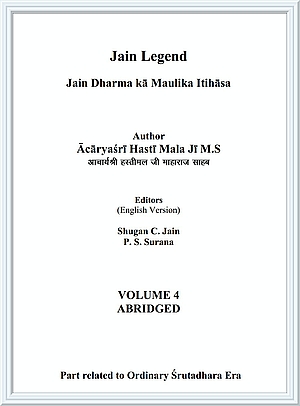The thorough understanding of scriptures and the 13 questions, 58 and 34 dictums and 54 questions under the heading 'Kehanī Paramparā' which illustrate the essence of Jain scriptures, had left such a remarkable influence in the hearts of devotees of Jainism that not only the laity but even a monk like Harṣa Kīrti, a self-seeker (Ātmārthī) also openly condemned the lax-monks of material based rituals traditions who were engaged in hoarding money and openly attacked and opposed their Nonscriptural high profile rituals. He left his gaccha, joined Lokāśāha and started propagating the authentic scripture based path of salvation. The miraculous influence of unique scripture-based religious revolution launched by Lokāśāha resulted in the devastation of age old fortifications of material based traditions. And the non-scriptural superfluous rituals and conduct introduced by ācāryas were cast away by the typhoon of scripture-based holy path remained floating unsupported like cotton burst open from its secure pod.
The cyclone of religious revolution badly hit the floating income of the luxury-addicted ācāryas, monks, etc. and they in their bewilderment combined with helplessness started writing abusive, venomous literature against Lokāśāha and his parents too.
Keeping in view the different vitiated versions regarding the life history, personality and authorship of Lokāśāha, written by ācāryas and scholars of different heretical traditions, we have presented the different opinions prevalent and available in the Jain literature till date, in Jain Dharma kā Maulika Itihāsa Vol. 4, pp. 702 to 751, exactly in the same form, to provide information to the lovers of history. The different opinions about his birth, birth place, time, date of his authorship, date of commencement of his sermons, launching the pure code of conduct, controversies regarding his initiation (whether he had taken initiation or not), views expressed about Lokāśāha by Ratna Nandi, the Digambarācārya etc. were presented in the 4th volume. This information is not provided in this text owing to space constraint.
Lokāgaccha tradition - Original name Jinamatī
In the entire Jain literature available so far, the tradition founded by Lokāśāha is called as Lokāgaccha, Lūṃpaka gaccha, Lūṃpāka gaccha and Jinamatī only. Except these, no other name is found in any literature. As far as the name Lokā gaccha is concerned, a person like Lokāśāha, an ideal, renouncer and lover of Jina Order would never under any circumstances accept to name the great religious congregation of Mahāvīra after himself as Lokā gaccha. With regard to the names Lūṃpaka gaccha, Lūṃpāka gaccha - the two words Lūṃpaka or Lūṃpāka means robber. No decent congregation calls itself as congregation of robbers. These terms were used in the Paṭṭāvalīs, poetry, quatrains, Bhāsa / bards etc. written by the gacchas opposing this pure tradition. The use of abusive words for an unblemished tradition is found often in the contemporary literature too. Besides, in many Paṭṭāvalīs of Lokā gaccha it is clearly mentioned that the pure ascetic path or the compassionate path which was an outcome of spiritual revolution of Lokāśāha was nicknamed contemptuously by the hostile gacchas as Lūṃkā gaccha or Lokā gaccha.
Now only one name remained - the name Jinamatī. From the analytical study of the information given in 'Gacchācāra Vidhi' acquired from Baḍaudā University and the Paṭṭāvalī available from Siṃghavī Pola Bhanḍ ā ra of Khambhatā, it becomes clear that Lokāśāha brought into light the age old Suvihita tradition in front of the people, in the attire of scriptures and named it as 'Jinamata' or 'Jinamatī'. This is substantiated by the appeal letters written by the laity to the monks of this tradition as they used the word Jinamatī before or after the name of that particular monk. Lokāśāha giving the name 'Jinamatī' to the four-fold order established by Śramaṇa Mahāvīra to achieve universal welfare and beneficence appears quite appropriate.
Two ancient letters which throw light on certain controversial matters about the life of Lokāśāha that were written 55-56 years ago were found by Monk Kṛṣṇajī, the disciple of Maṃgalajī Swāmī of Līṃbadī Motā monastery tradition. Kṛṣṇajī got these letters from Śrī Gorajī Sundarajī, the Yati of Nānī Pakṣa of the gaccha. Those two letters were attached at the end of an ancient copy of Kalpasūtra, which belonged to the period of first phase of Vikram 17th century. Those two letters were written by Kāntivijaya, the disciple of Tapā gacchīya Yati Nāyaka Vijaya in Pāṭaṇa on Basanta Paṃcamī in 1636. This was mentioned by the scribe himself at the end of the two letters. Obtaining the permission from Yati Sundara jī, Śrī Kṛṣṇajī Swāmī made copies of those two letters and kept them with him.
After sometime Śrī Kṛṣṇajī sent the duplicate copies of letters to Monk Maṇilālajī, the author of 'Jain Dharma no Prācīna Saṃkṣipta Itihāsa' (A Brief ancient history of Jainism). The author printed these letters as they were in his abovementioned treatise. Monk Maṇilālajī was the disciple of revered Mohanalālajī Swāmī of Līṃbaḍī Congregation Monastic tradition.
These two letters which bring out unique and significant facts in the life of Lokāśāha are given below:
 Acharya Hasti Mala
Acharya Hasti Mala
